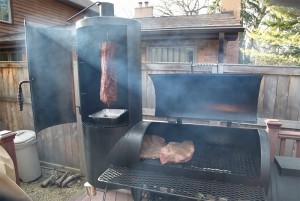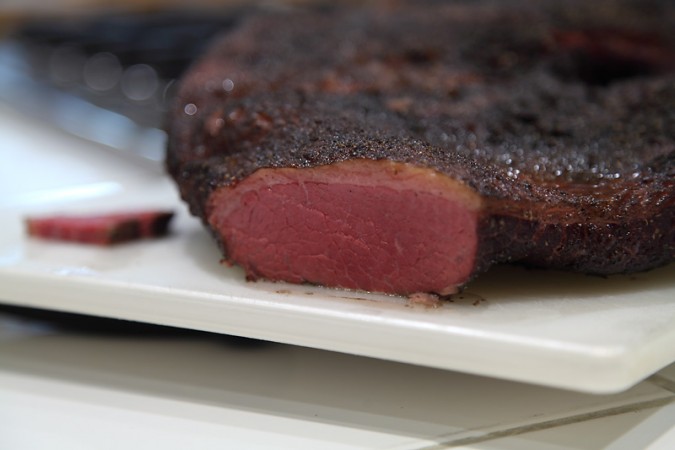By Ronnie Suburban
This one’s based on a recipe from “Charcuterie” by Michael Ruhlman and Brian Polcyn.
A 10-13 pound whole brisket, trimmed*
For the Cure:
1 ½ gallons cold water
½ gallon ice water
700 grams kosher salt
14 grams pink salt (this is the amount to use for up to 25 pounds of meat**)
2 T. pickling spice
1 cup brown sugar (packed)
½ cup honey
10 garlic cloves, crushed
Before smoking:
16 grams coriander seeds, lightly toasted
20 grams black peppercorns, lightly toasted
Method
1. Completely dissolve the salts, sugar, honey and pickling spice in 1 ½ gallons of water. Do this over low heat if you have to, but these items will normally dissolve in cold water after some stirring (obviously, some elements of the pickling spice will not dissolve at all). Add the garlic. Stir until combined thoroughly. Add the ½ gallon of ice water to bring the temperature of the cure down. The cure must be cold (38° Fahrenheit or lower) in order for this to work properly and be safe.
 2. Fully submerge the brisket in the cure. If it floats, you can keep it submerged by placing a non-reactive plate on top of it. Depending on the thickness of the brisket, leave it in the cure for 7-10 days, so that the cure penetrates to the deepest part of the brisket. Or, you can inject the cure into the center of those thick portions of the brisket and reduce the cure time to 3-4 days.
2. Fully submerge the brisket in the cure. If it floats, you can keep it submerged by placing a non-reactive plate on top of it. Depending on the thickness of the brisket, leave it in the cure for 7-10 days, so that the cure penetrates to the deepest part of the brisket. Or, you can inject the cure into the center of those thick portions of the brisket and reduce the cure time to 3-4 days.
IMPORTANT: If you used heat to make the cure, refrigerate it until it reaches temperature before adding the brisket.
3. After the brisket has cured fully, rinse it off completely. Pat the brisket dry. If you have time, place the cured brisket, uncovered – or wrapped in a single layer of cheesecloth – in refrigeration for 24 hours at (or around) 38° F. but do not freeze it. This extra step produces a pellicle, which allows the smoke to adhere to the brisket better. My experience is that it is not really necessary.
4. After the brisket is dry, lightly toast the black pepper and coriander seeds in a dry sauté pan. After they are toasted, grind them coarsely, mix them together thoroughly and rub the entire brisket with the mixture.
5. Hot-smoke the cured, rubbed brisket fat-side down at 200-250° F. for up to six hours over a wood of your choice: apple, hickory or oak are good ones. If you like it smokier, smoke it long but do not let the internal temperature of the brisket rise above 150° F. If it hits 150° F., remove it from the smoker. The key here is that if the pastrami gets to 150° F too soon, it will not have a lot of smokiness. There really is no downside to smoking it longer (or at a lower temperature) because the final step is a braise, which will cook the pastrami fully if smoking did not get it to that point. Just make sure you do not exceed 150° F. during the smoking process or the exterior of the meat will become dry and desiccated. For restaurant applications, there may be other food-safety regulations that must be followed.
6. After the pastrami has received the desired amount of smoke or reached 150° F., it should be braised before serving. Braising will not only make it extremely tender but will also rid the meat of excess saltiness. I generally braise it for four hours at 275° F. Your mileage may vary.
7. After placing the pastrami in the braising vessel, I fill the vessel about halfway up the brisket with cold water. After about two hours of covered braising, I dump out 90 percent of the water, flip the brisket over, re-fill the vessel again to halfway up the brisket with fresh water, and continue to braise for another two hours. I find that it’s best to braise fat-side-down first and fat-side-up second. The pepper and coriander mix, if applied before smoking, will adhere to the brisket during braising. You’ll lose some of it but not enough to be a problem.
8. After the braise all you have to do is slice (against the grain) and serve.
————–
*Pastrami has an important, defining rub on the outside, so how you trim the brisket before you prepare it is important. You need some fat on the outside to protect it during the smoking process. However, because the fat – which carries the black pepper and coriander – will ultimately be eaten, leaving too much on will result in a fairly unpalatable final product. If you trim the fat after the smoking, you’ll lose the spicy crust that is key to a good pastrami. So, trim the brisket well before curing. I generally try to separate the point from the flat, leaving it attached. I also try to leave about ¼” of fat on the exterior of the brisket.
**This recipe is scalable, depending on how much meat you use. However, the pink salt, which can be dangerous if used in excess, is not as adjustable. Use 1 teaspoon for up to 25 pounds of meat. If you use less than 10 pounds of meat, you might want to consider using even less pink salt.


